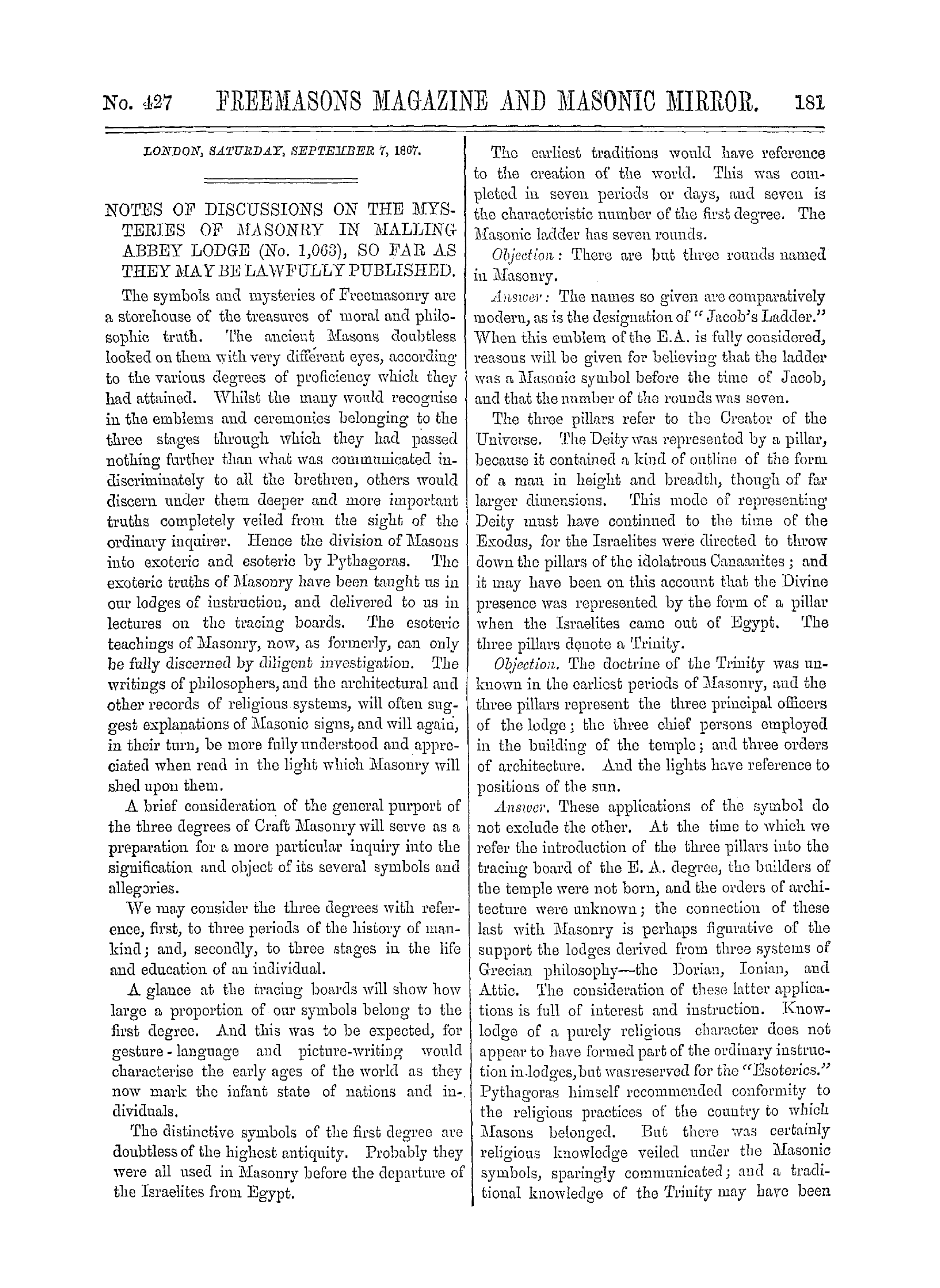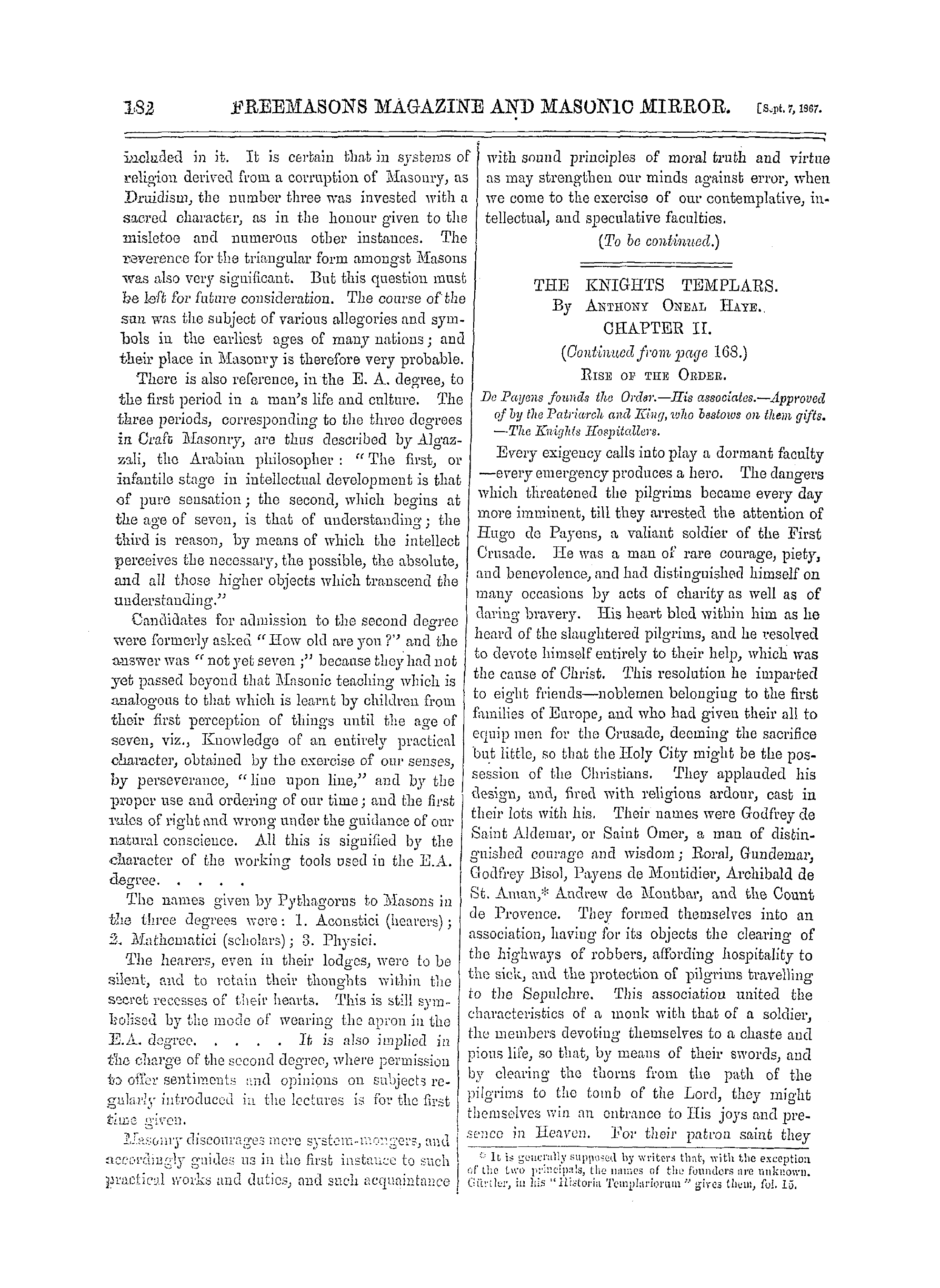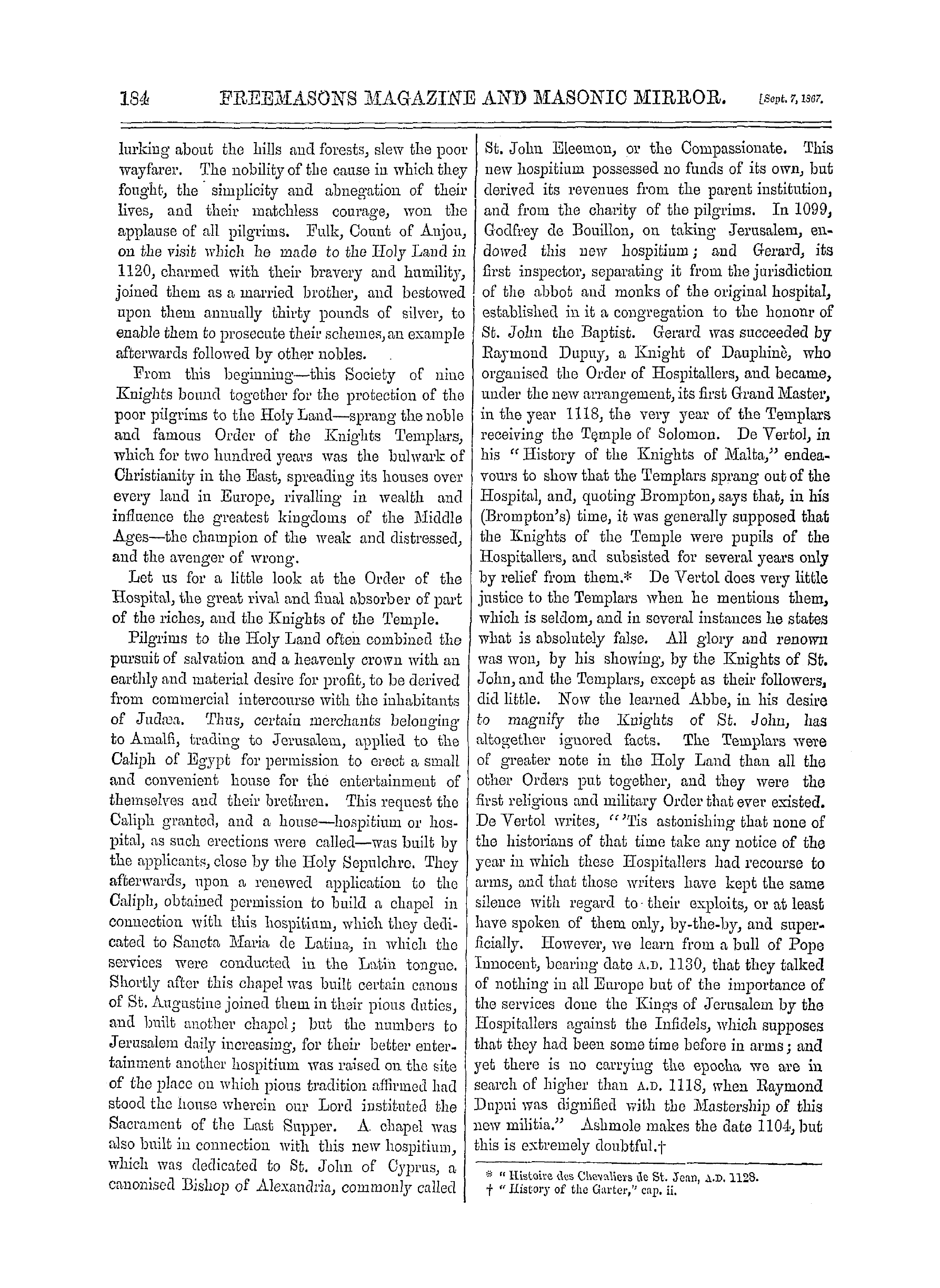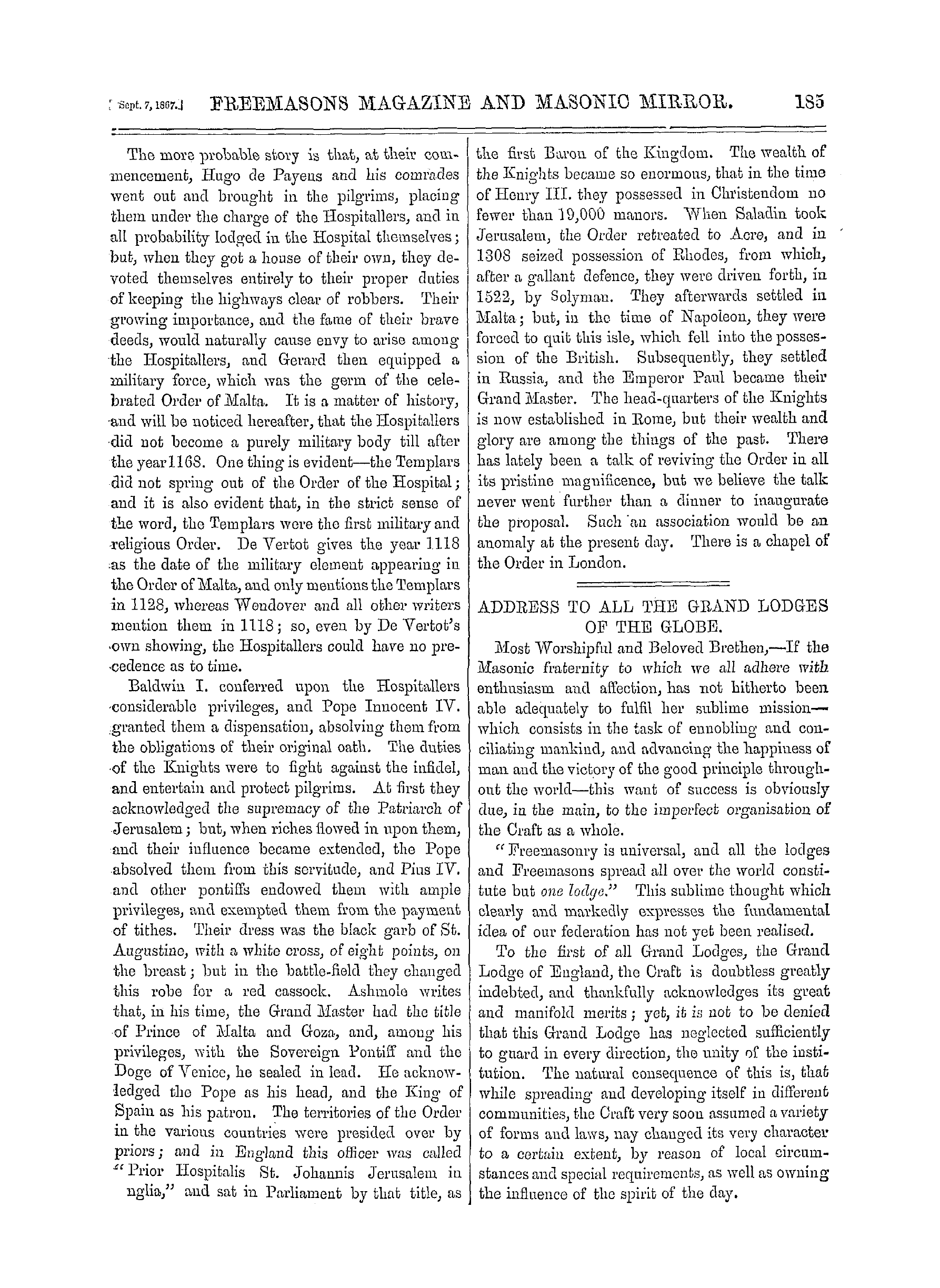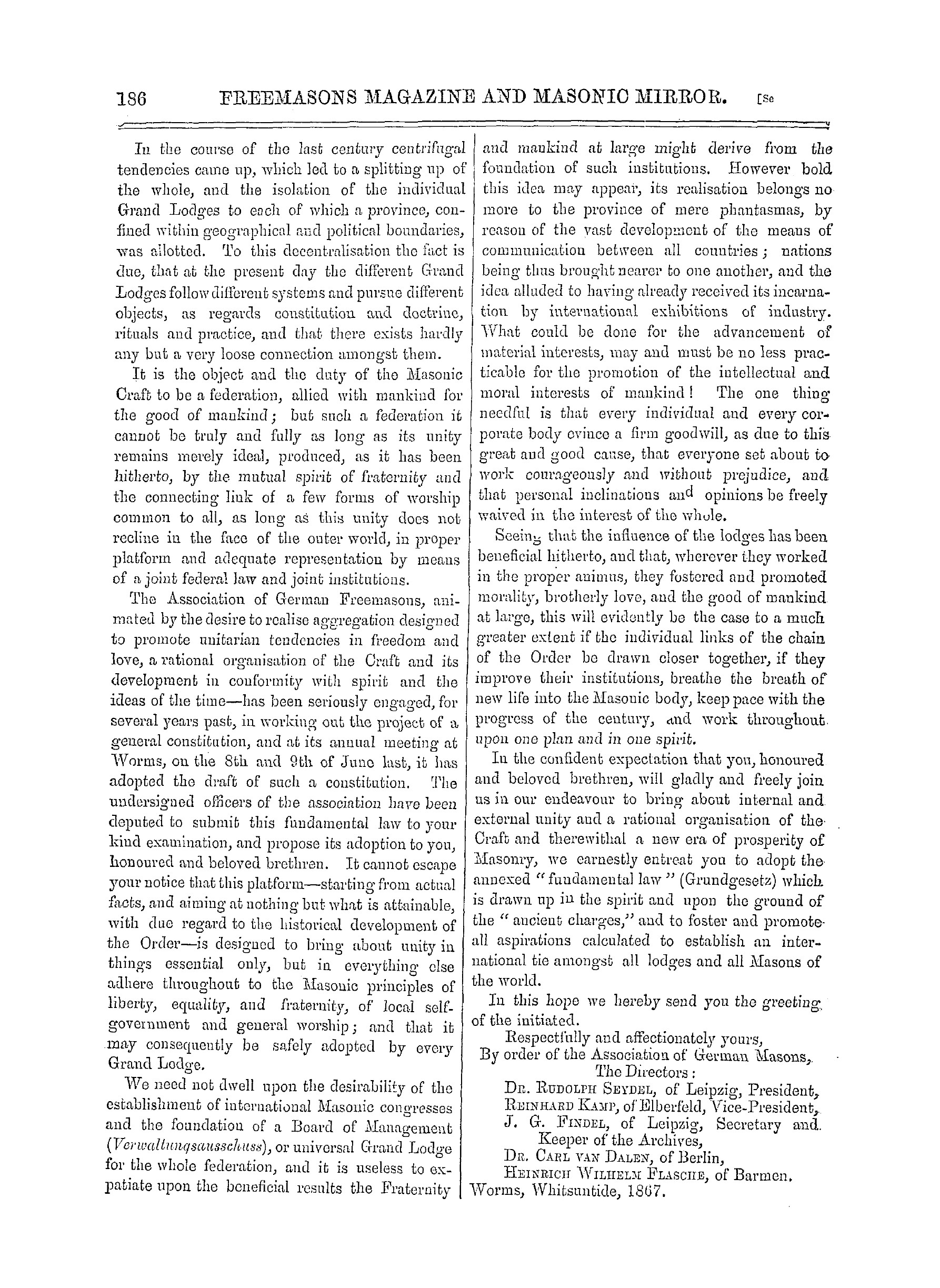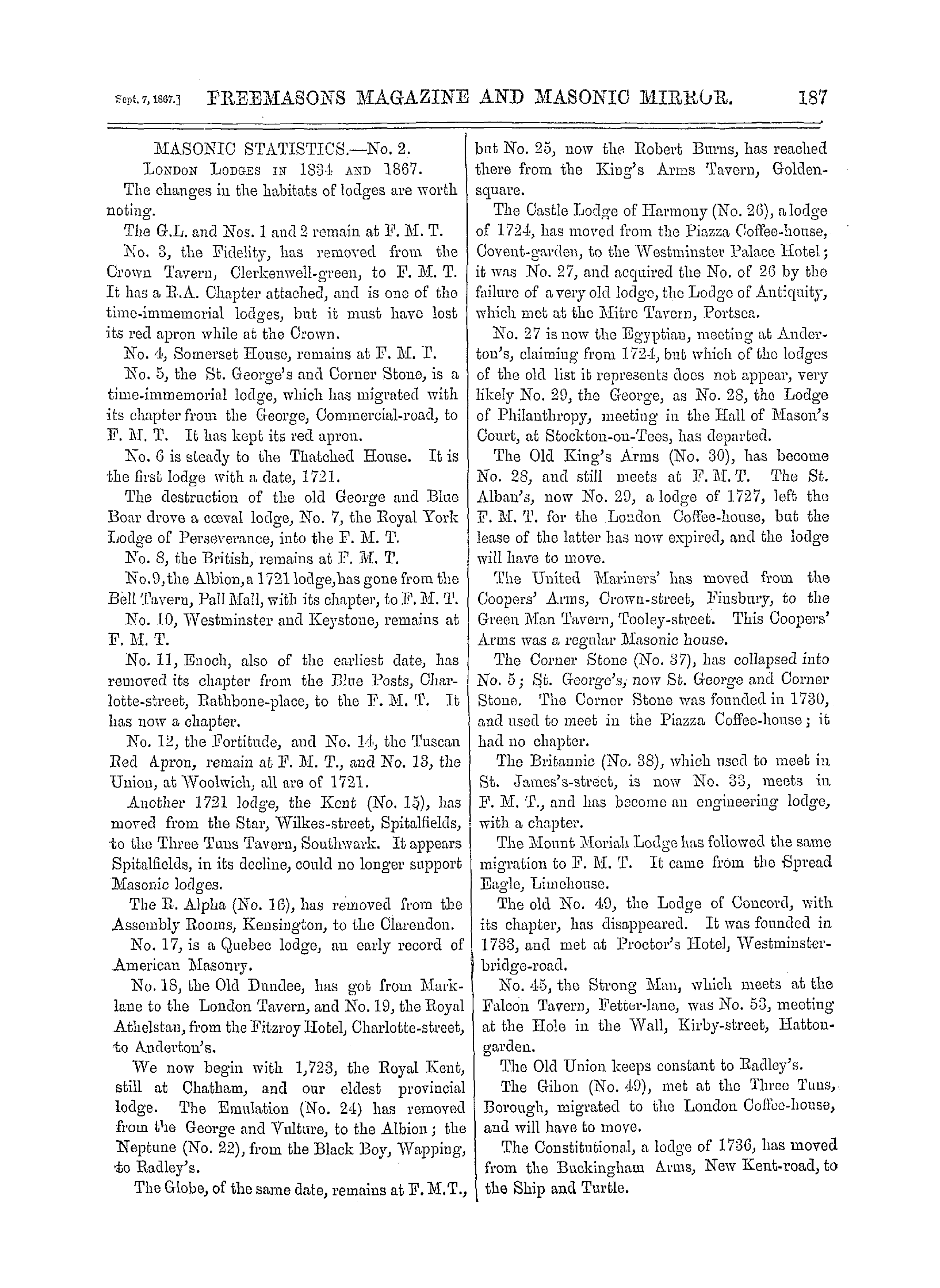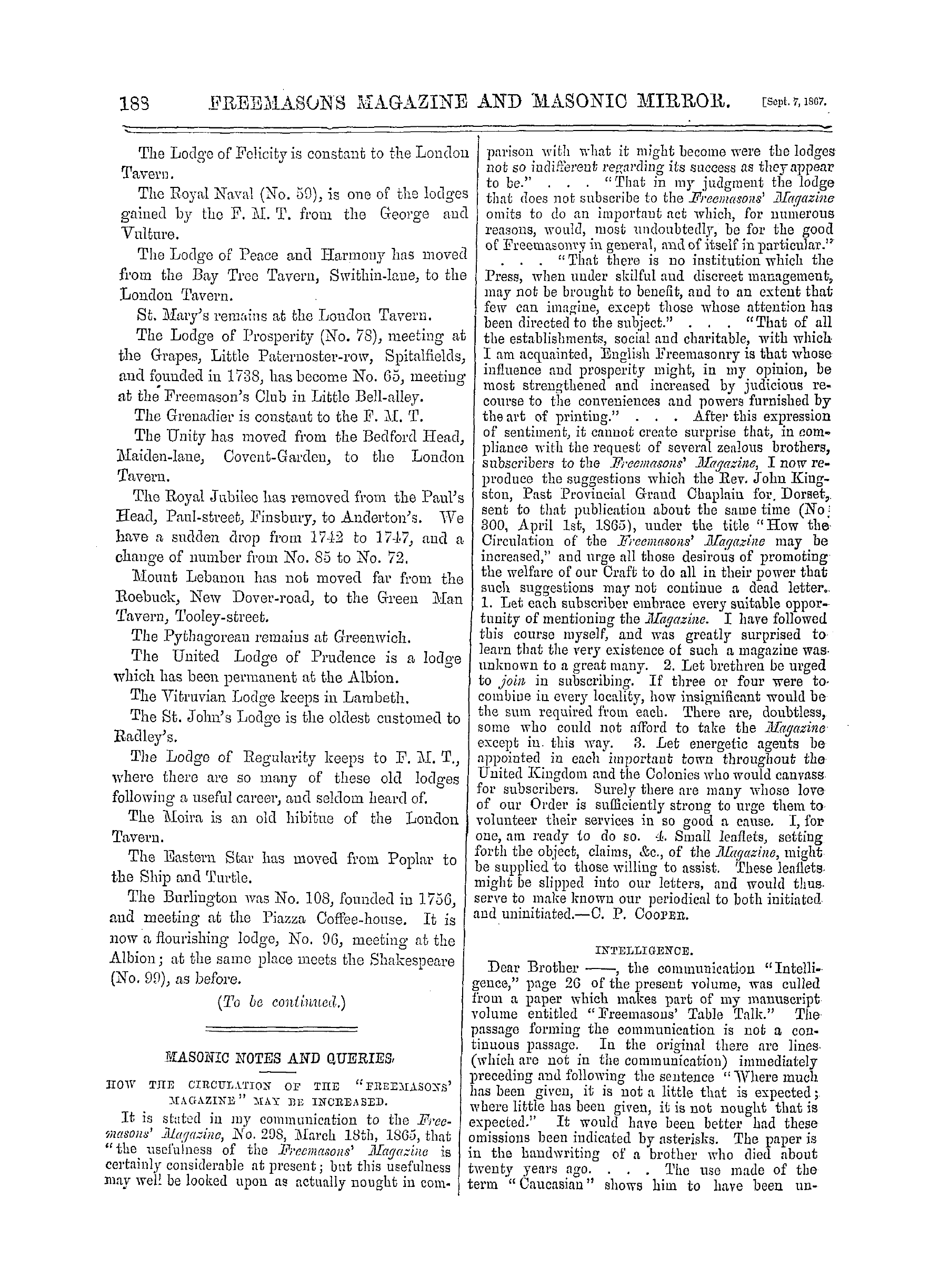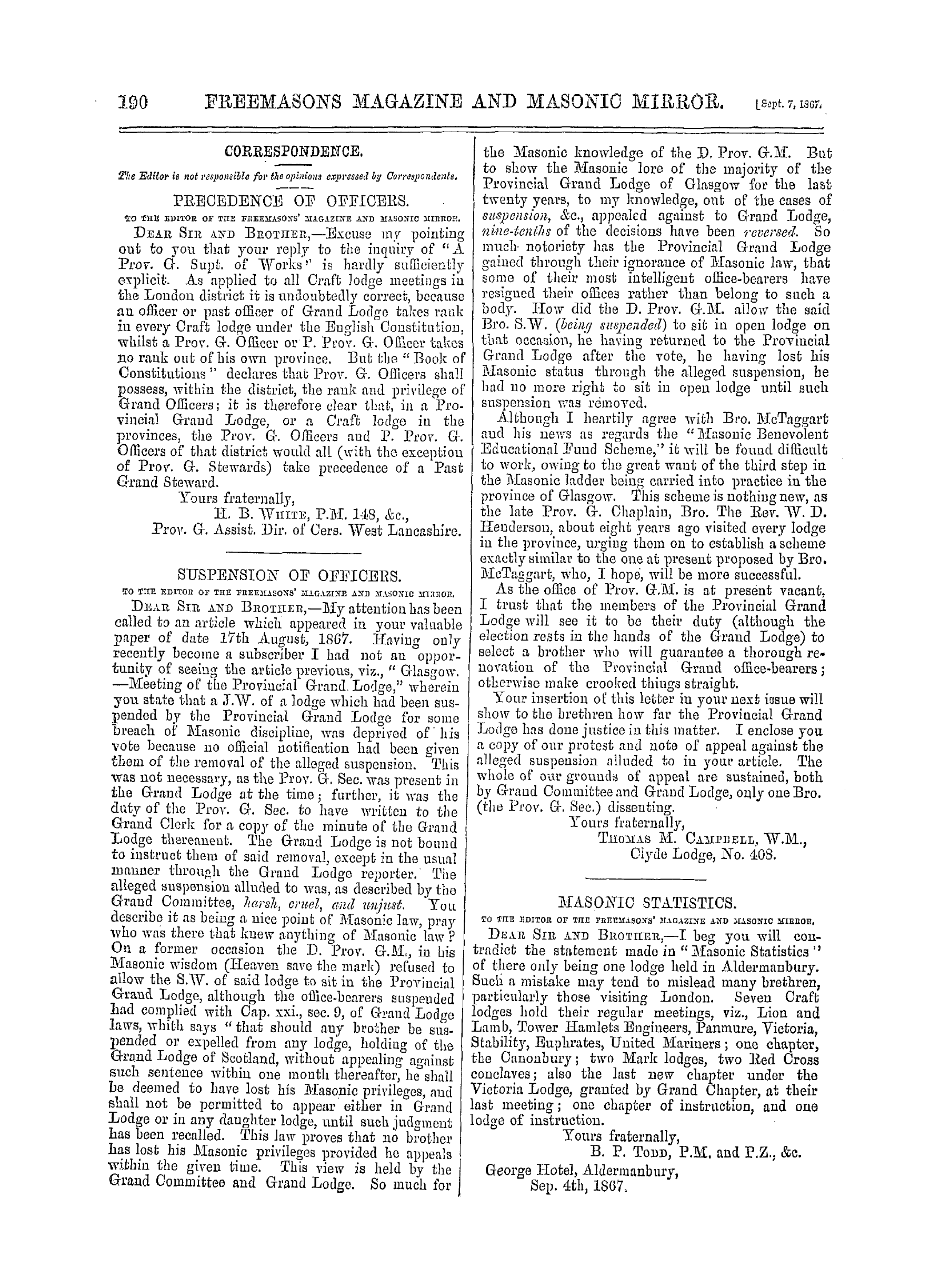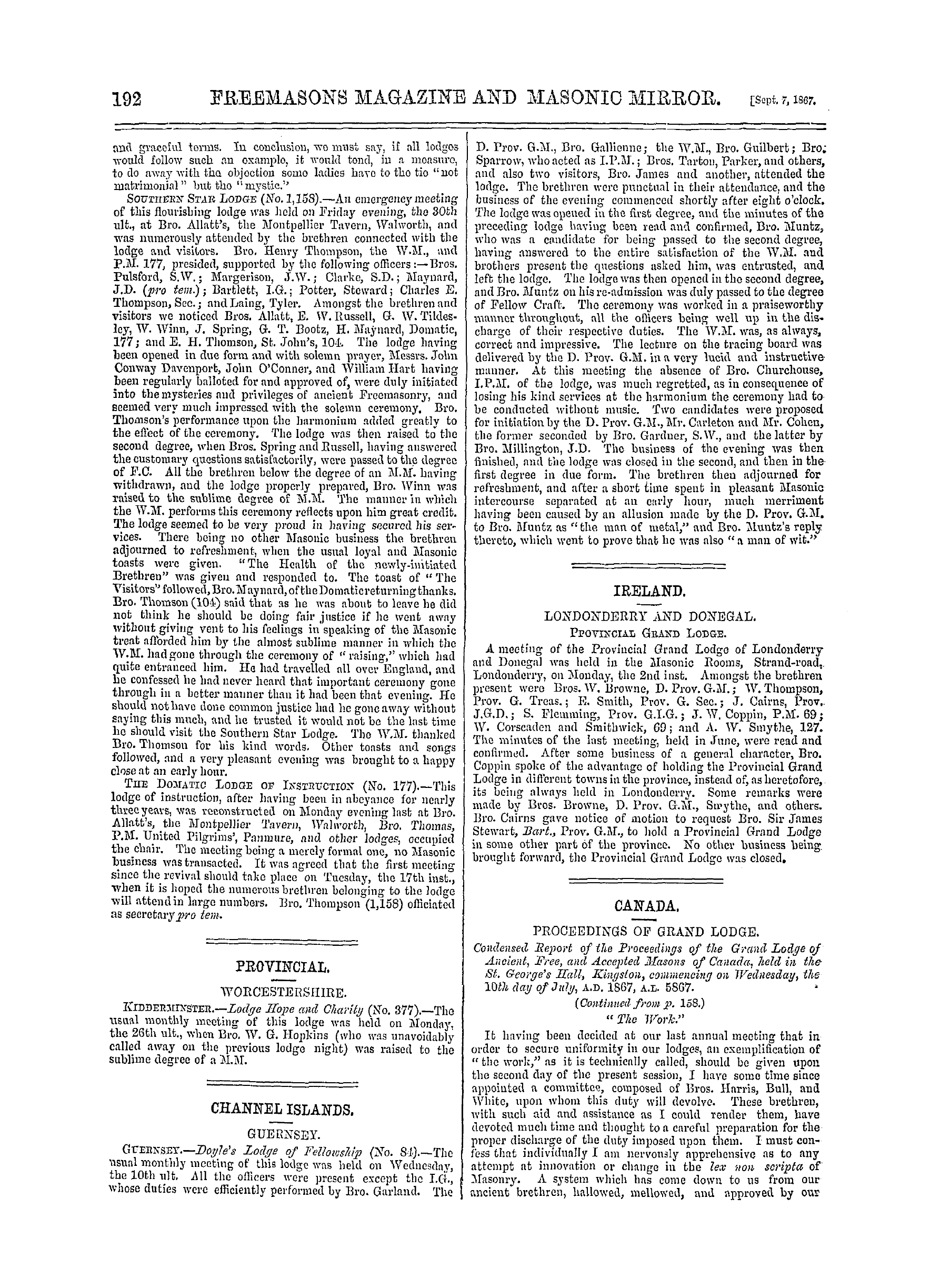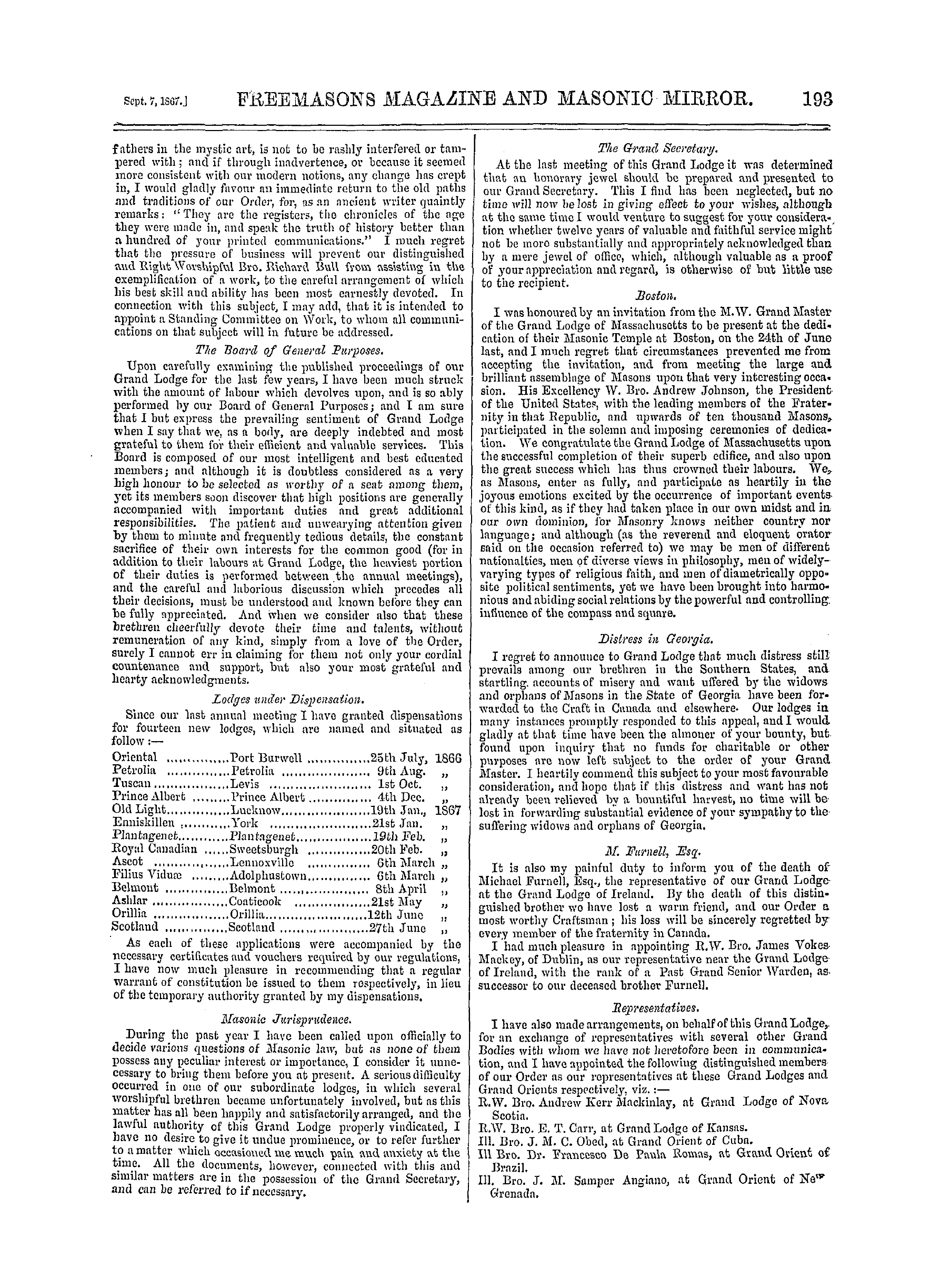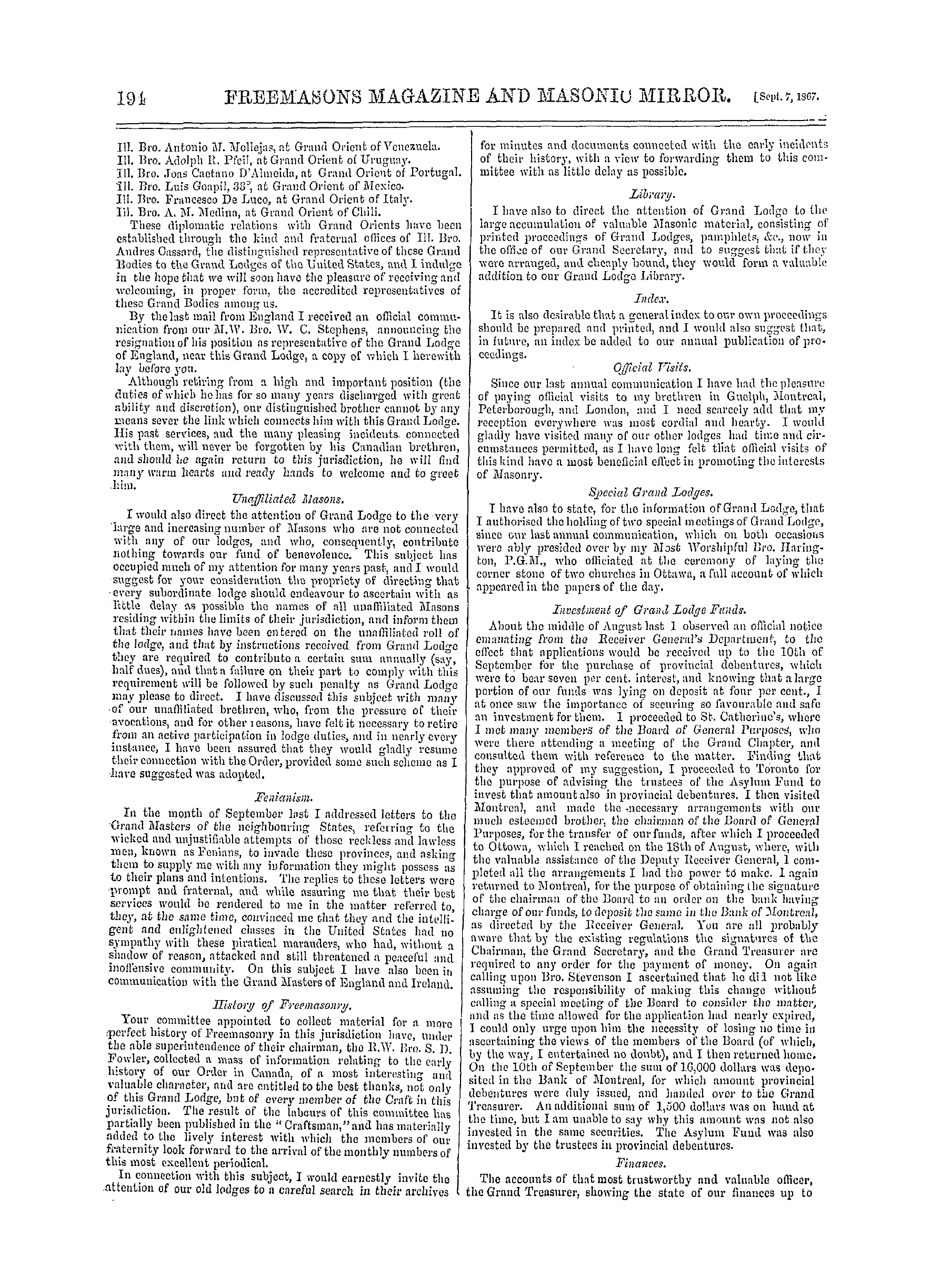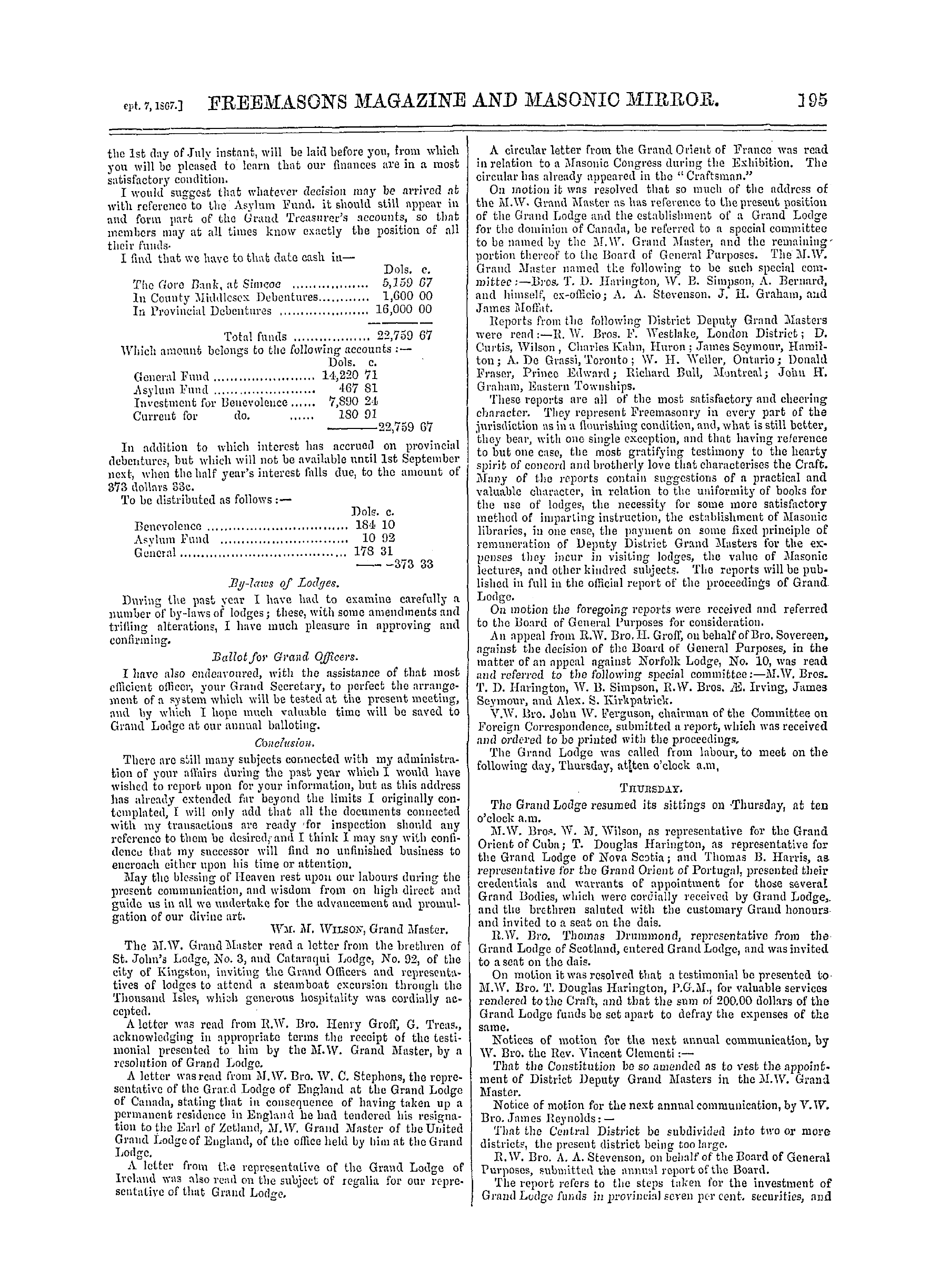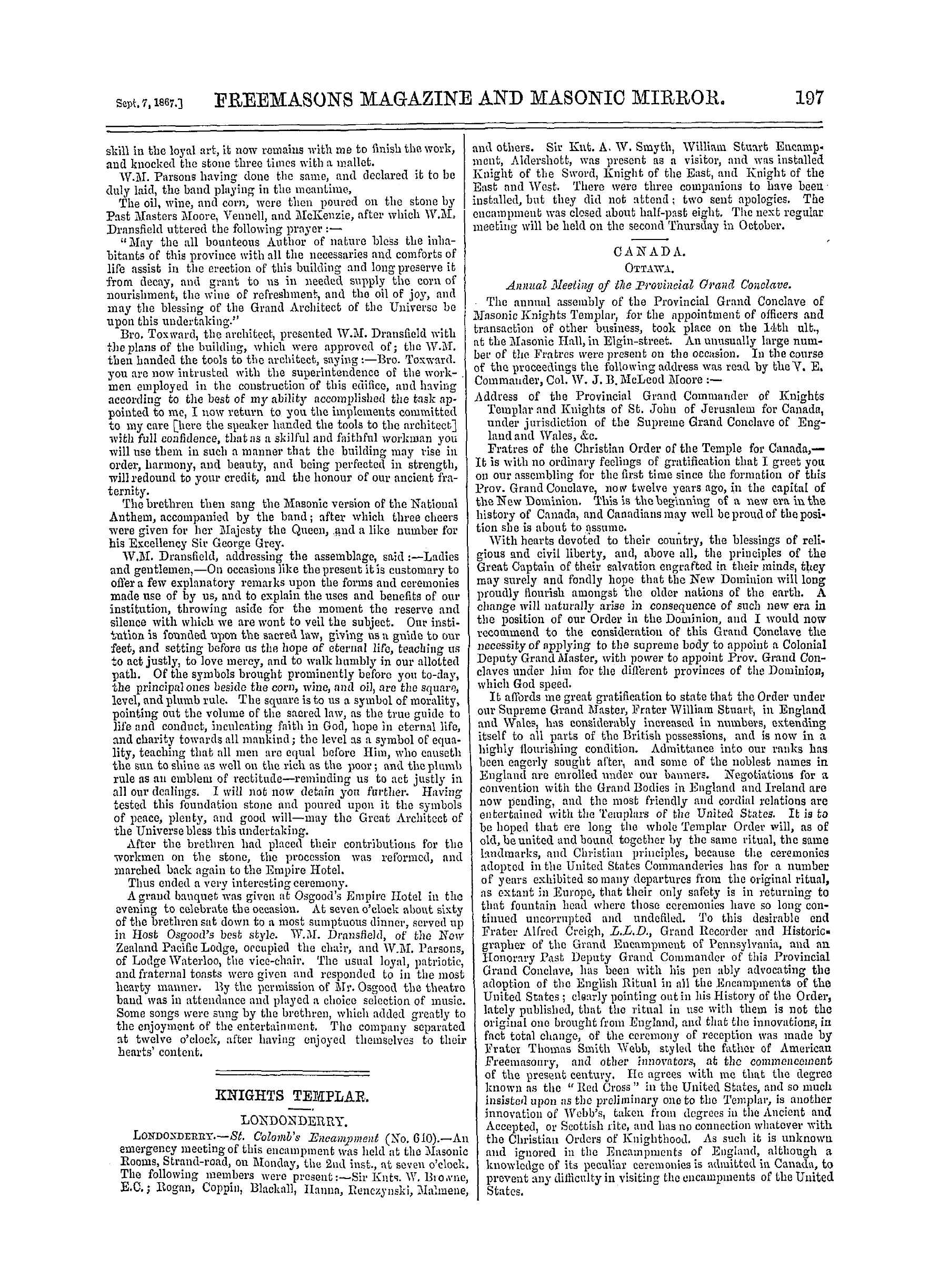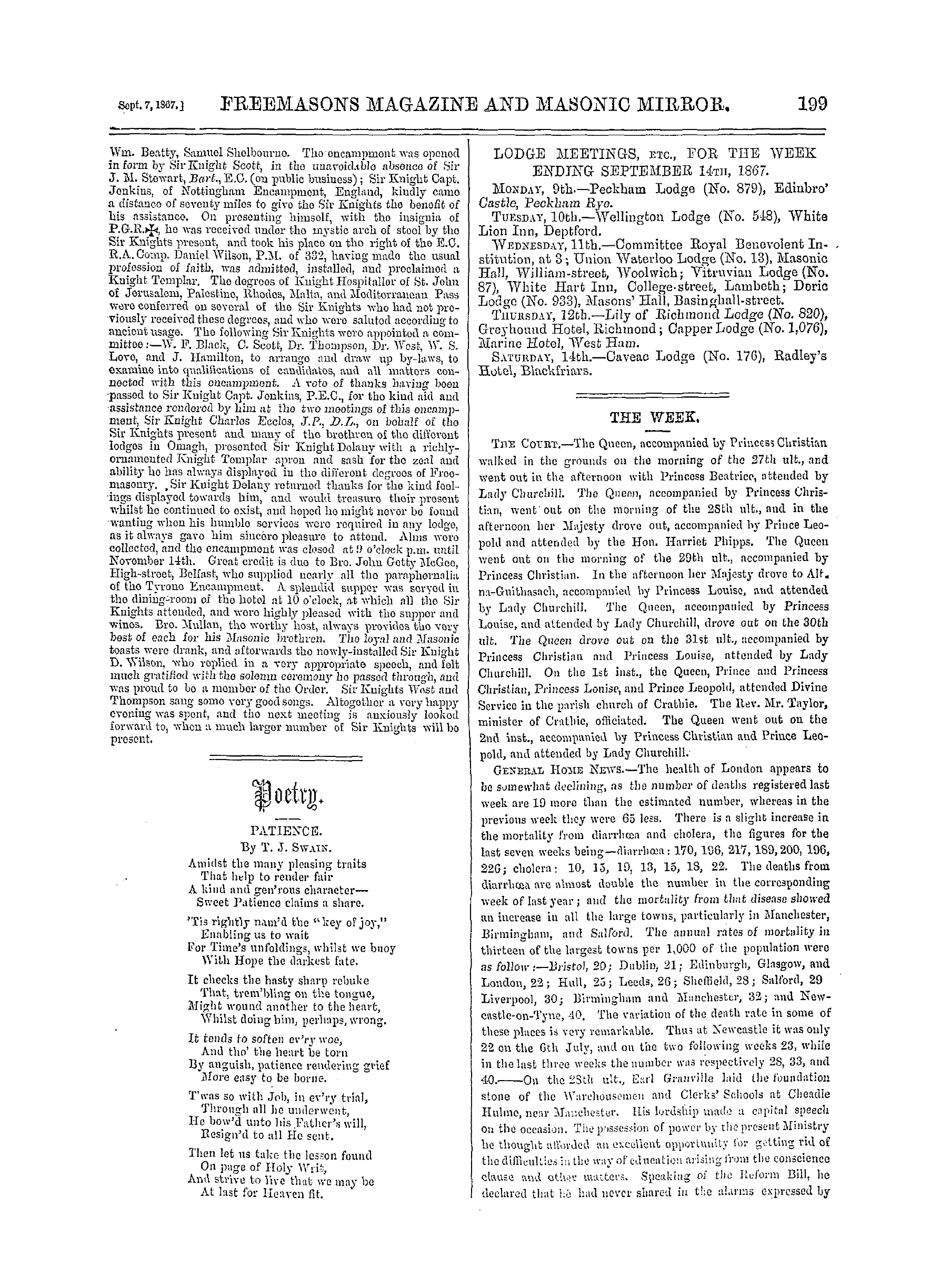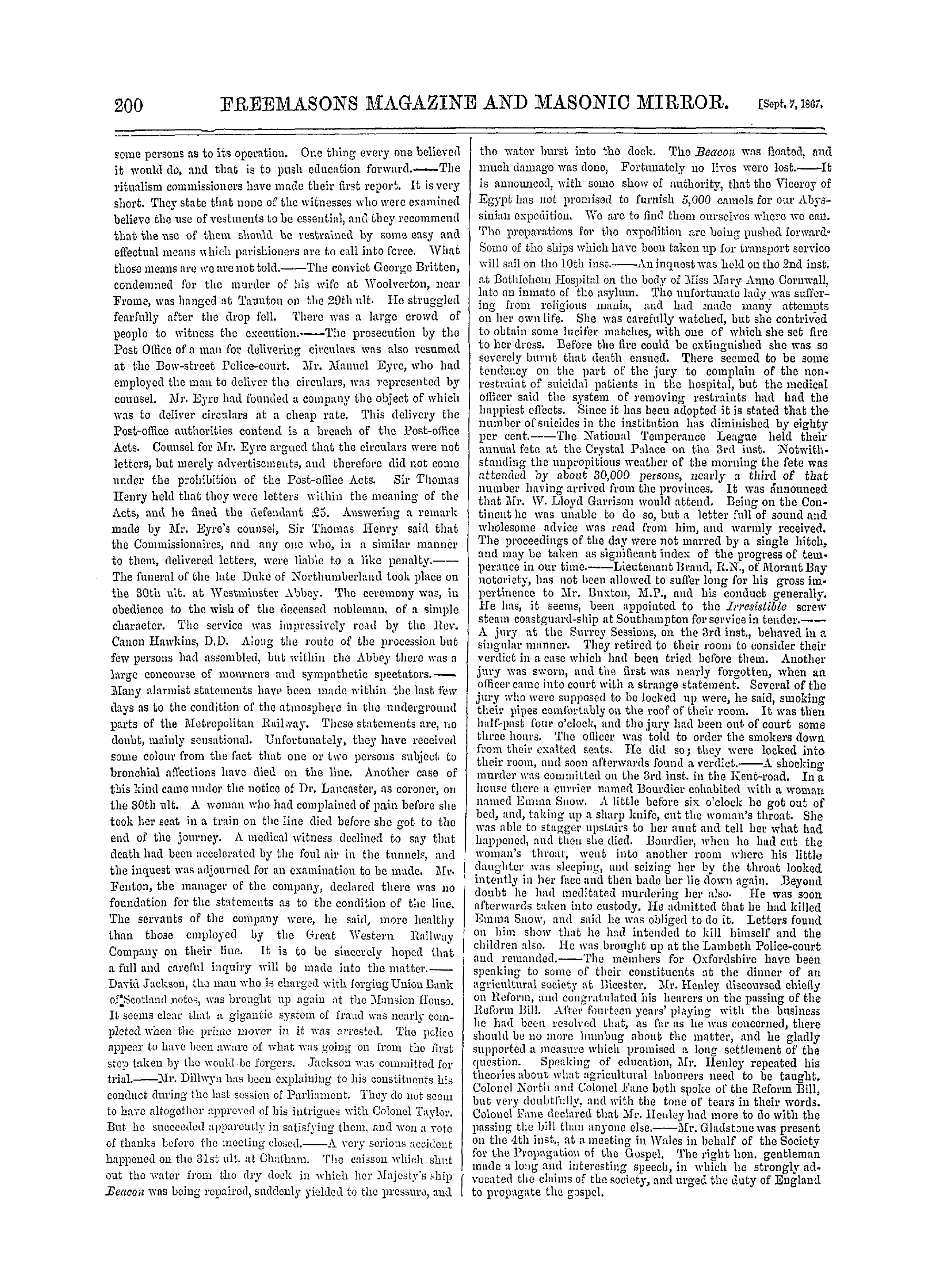-
Articles/Ads
Article MASONIC NOTES AND QUERIES. ← Page 2 of 2
Note: This text has been automatically extracted via Optical Character Recognition (OCR) software.
Masonic Notes And Queries.
acquainted with the advance made in ethnology since the days of Blumenbach . . . . The paper , however , deserves printing in its entirety . Your transcription of it when at Denton Court has escaped my recollection . But , as you are in possession of a copy , send it at once to the Freemasons' Magazine .
Although it contains much that is not Masonic , it will not be out of place in that useful and meritorious publication . —C . P . COOPEE .
EEENCH PEEEMASONEY . Frencli Freemasonry , by the toleration of Atheism , has ceased to be true Freemasonry . —From a manuscript volume in Bro . Purton Cooper's Masonic collections entitled " Freemasons' Table Talk . "
PEEEHASONRY ' s MOST ESSENTIAL PAET . A young brother is mistaken . Freemasonry's most essential part is that which our reason duly employed teaches ; ancl our reason duly employed teaches us at all times and at all places . It teaches when we are out of lodge , as it teaches when we are in lodge . It is not , therefore , in lodge only that Freemasonry ' s most essential part may be learnt . — C . P . COOPEE .
WHY IS KENTUCKY UNIVERSITY CALLED MASONIC ? Bro . Murray Lyon is a Master of Arts of the Masonic University of Kentucky ; and the correspondent asking this question should look at Bro . Lyons' extract from a sketch of this institution received from its Principal , Bro . Robert Morris , LL . D ., and printed in the Freemasons' Magazine , vol . x ., page 197 . —C . P . COOPEE .
THE DIONYSIAN ARCHITECTS . The Dionysian architects had all been initiated in the Dionysian mysteries . In those mysteries they had learnt the doctrines of the One God and of the soul ' s immortality . There were Dionysian architects in Tyre at the time of the building of the Temple of
Jerusalem . Hiram , the widow's son , was one of such architects . . . . This , my dear young friend , is one of those myths with which Masonic histories teem . Your love of poetry and romance is , I know , much too great for such myths not to please you . — C . P . COOPEE .
! KING HENRY THE SEVENTH . My dear young friend , King Henry the Seventh is said to have been a Freemason . This is the only part of your question that I am able to answer . You should look into our Masonic histories . —C . P . COOPEE .
CENTENARIES IN 1 SG 7 . The following are the lodges , founded in 1767 , which attain their centenary in the present year , and are entitled to petition the M . W . G . M . for a centenary medal : — So . 163 . Integrity , of Manchester .
„ 164 . Perseverance , of Sidmouth . „ 165 . Honour and Generosity , of London . „ 160 . Union , of London . „ 107 . St . John ' s , of Hampstead . „ 168 . Mariners , of Guernsey . „ 169 . Temperance , of Deptford . „ 170 . All Souls , of Weymouth , „ 171 . Amity , of London .
For thirty years no lodge of 1767 has become extinct . May they long flourish . —F . HASONIC PLACES OE MEETING . Is it Masonic or right for lodges to meet-in houses belonging to non-Masons in toivns where there are
suitable houses belonging to Masons or their widows ? Is there , iu fact , any provision to ensure such a desirable course ? Do the Grand Lodge , District , or Provincial authorities take the least care about the places of meeting or granting warrants or dispensations ?
Should not this point be distinctly investigated by some officer ? Who so lit as the Grand Superintendent of Works , the D . S . G . W ., or the Prov . S . G . W ., and why should not his report be required before the grant of a warrant or dispensation , and why should he not make a yearly report to his G . M .
and Grand Lodge ? This would make something for him to do . Generally speaking , except at headquarters , the S . G . W . is a non-combatant . What ia here proposed would place the dignity on the footing of a working office . —A P . PEOV . & " . OITICEB .
DE . 0 __ iIA ER ' S QITOTJVTIONS PE 05 I "ENGLISH KOYAL ARCH" ( Spencer , London ) . "In the present instance I have been influenced by a twofold motive . First , to place the Royal Arch on its legitimate basis ; ancl , secondly , to furnish the reader with all the information respecting its origin
and elementary principles which study and reflection , augmented by a competent knowledge of the continental systems , has enabled me to collect together . — Preface , page 12 . "Freemasonry is a Christian institution , established bChristian menand embracing Christian
y , principles , a truth which may , indeed , be gathered from any of my numerous publications on the subject of Masonry . My faith in this respect commenced at my initiation , when I was only eighteen years of age , ancl has remained unshaken through a long ancl eventful life ; and I rejoice in the opportunity of
publicly professing the same faith at the age of eighty-five years . —Preface , page 19 . " The next important question whicli remains open at the present clay is the true origin of the English Royal Arch . . . . Some believe it was unknown before 1780 . . . . There exists sufficient evidence
to disprove all these conjectures , aud to fix tho error of its introduction to a period whicli is coeval with the memorable schism amongst the English Masons about the middle of the last century . —Pane 6 .
" At my first exaltation , in 1813 , I was taught to believe it an ancient degree ; but I confess that , even at that early period , I entertained considerable doubts on the point . The degree is too incongruous to be of any great antiquity . . . . The earliest mention of it in England whicli I can find is in the
year 1740 , just one year after the trifling alteration sanctioned by the modern lodge mentioned . "Dr . Oliver ' s "Eoyal Arch , " page 26 . N . B . The above commences a series of observations on the origin of the Royal Arch of England , by the learned doctor and divine , and no one anxious to understand the question should remain long without the work . —W . J . HUGHAN .
Note: This text has been automatically extracted via Optical Character Recognition (OCR) software.
Masonic Notes And Queries.
acquainted with the advance made in ethnology since the days of Blumenbach . . . . The paper , however , deserves printing in its entirety . Your transcription of it when at Denton Court has escaped my recollection . But , as you are in possession of a copy , send it at once to the Freemasons' Magazine .
Although it contains much that is not Masonic , it will not be out of place in that useful and meritorious publication . —C . P . COOPEE .
EEENCH PEEEMASONEY . Frencli Freemasonry , by the toleration of Atheism , has ceased to be true Freemasonry . —From a manuscript volume in Bro . Purton Cooper's Masonic collections entitled " Freemasons' Table Talk . "
PEEEHASONRY ' s MOST ESSENTIAL PAET . A young brother is mistaken . Freemasonry's most essential part is that which our reason duly employed teaches ; ancl our reason duly employed teaches us at all times and at all places . It teaches when we are out of lodge , as it teaches when we are in lodge . It is not , therefore , in lodge only that Freemasonry ' s most essential part may be learnt . — C . P . COOPEE .
WHY IS KENTUCKY UNIVERSITY CALLED MASONIC ? Bro . Murray Lyon is a Master of Arts of the Masonic University of Kentucky ; and the correspondent asking this question should look at Bro . Lyons' extract from a sketch of this institution received from its Principal , Bro . Robert Morris , LL . D ., and printed in the Freemasons' Magazine , vol . x ., page 197 . —C . P . COOPEE .
THE DIONYSIAN ARCHITECTS . The Dionysian architects had all been initiated in the Dionysian mysteries . In those mysteries they had learnt the doctrines of the One God and of the soul ' s immortality . There were Dionysian architects in Tyre at the time of the building of the Temple of
Jerusalem . Hiram , the widow's son , was one of such architects . . . . This , my dear young friend , is one of those myths with which Masonic histories teem . Your love of poetry and romance is , I know , much too great for such myths not to please you . — C . P . COOPEE .
! KING HENRY THE SEVENTH . My dear young friend , King Henry the Seventh is said to have been a Freemason . This is the only part of your question that I am able to answer . You should look into our Masonic histories . —C . P . COOPEE .
CENTENARIES IN 1 SG 7 . The following are the lodges , founded in 1767 , which attain their centenary in the present year , and are entitled to petition the M . W . G . M . for a centenary medal : — So . 163 . Integrity , of Manchester .
„ 164 . Perseverance , of Sidmouth . „ 165 . Honour and Generosity , of London . „ 160 . Union , of London . „ 107 . St . John ' s , of Hampstead . „ 168 . Mariners , of Guernsey . „ 169 . Temperance , of Deptford . „ 170 . All Souls , of Weymouth , „ 171 . Amity , of London .
For thirty years no lodge of 1767 has become extinct . May they long flourish . —F . HASONIC PLACES OE MEETING . Is it Masonic or right for lodges to meet-in houses belonging to non-Masons in toivns where there are
suitable houses belonging to Masons or their widows ? Is there , iu fact , any provision to ensure such a desirable course ? Do the Grand Lodge , District , or Provincial authorities take the least care about the places of meeting or granting warrants or dispensations ?
Should not this point be distinctly investigated by some officer ? Who so lit as the Grand Superintendent of Works , the D . S . G . W ., or the Prov . S . G . W ., and why should not his report be required before the grant of a warrant or dispensation , and why should he not make a yearly report to his G . M .
and Grand Lodge ? This would make something for him to do . Generally speaking , except at headquarters , the S . G . W . is a non-combatant . What ia here proposed would place the dignity on the footing of a working office . —A P . PEOV . & " . OITICEB .
DE . 0 __ iIA ER ' S QITOTJVTIONS PE 05 I "ENGLISH KOYAL ARCH" ( Spencer , London ) . "In the present instance I have been influenced by a twofold motive . First , to place the Royal Arch on its legitimate basis ; ancl , secondly , to furnish the reader with all the information respecting its origin
and elementary principles which study and reflection , augmented by a competent knowledge of the continental systems , has enabled me to collect together . — Preface , page 12 . "Freemasonry is a Christian institution , established bChristian menand embracing Christian
y , principles , a truth which may , indeed , be gathered from any of my numerous publications on the subject of Masonry . My faith in this respect commenced at my initiation , when I was only eighteen years of age , ancl has remained unshaken through a long ancl eventful life ; and I rejoice in the opportunity of
publicly professing the same faith at the age of eighty-five years . —Preface , page 19 . " The next important question whicli remains open at the present clay is the true origin of the English Royal Arch . . . . Some believe it was unknown before 1780 . . . . There exists sufficient evidence
to disprove all these conjectures , aud to fix tho error of its introduction to a period whicli is coeval with the memorable schism amongst the English Masons about the middle of the last century . —Pane 6 .
" At my first exaltation , in 1813 , I was taught to believe it an ancient degree ; but I confess that , even at that early period , I entertained considerable doubts on the point . The degree is too incongruous to be of any great antiquity . . . . The earliest mention of it in England whicli I can find is in the
year 1740 , just one year after the trifling alteration sanctioned by the modern lodge mentioned . "Dr . Oliver ' s "Eoyal Arch , " page 26 . N . B . The above commences a series of observations on the origin of the Royal Arch of England , by the learned doctor and divine , and no one anxious to understand the question should remain long without the work . —W . J . HUGHAN .
